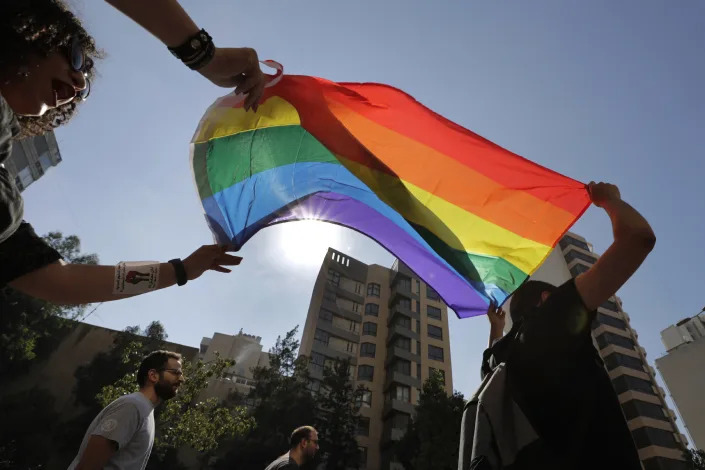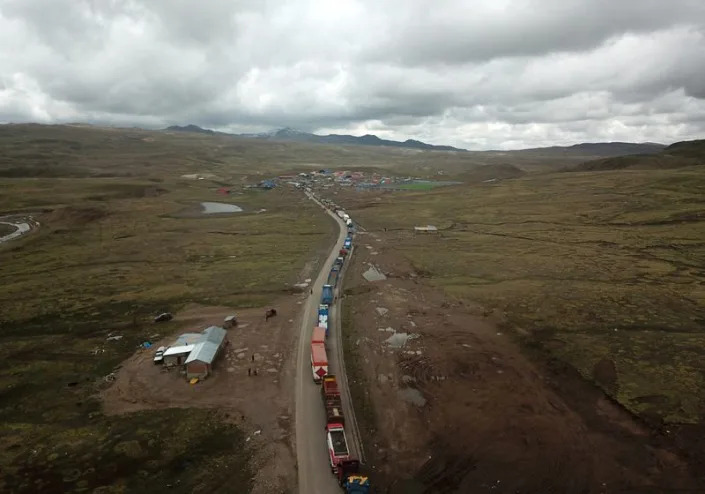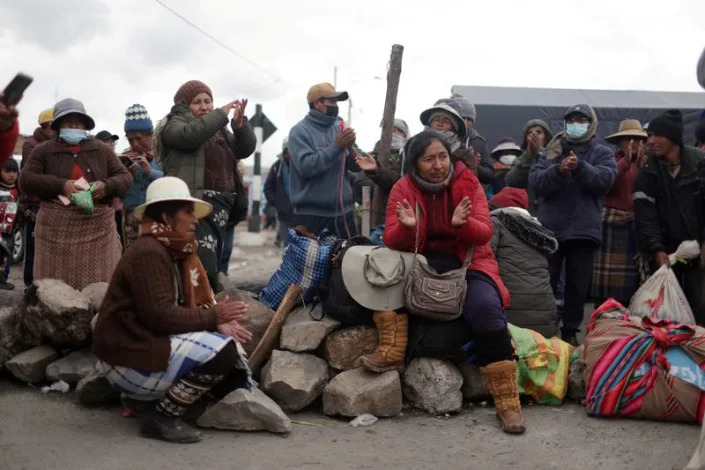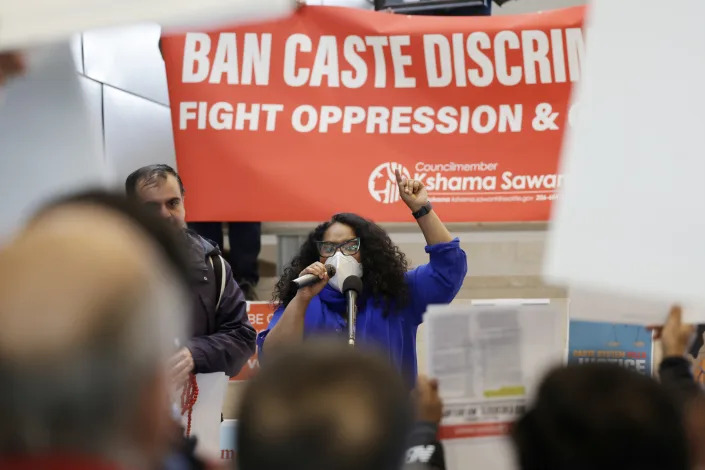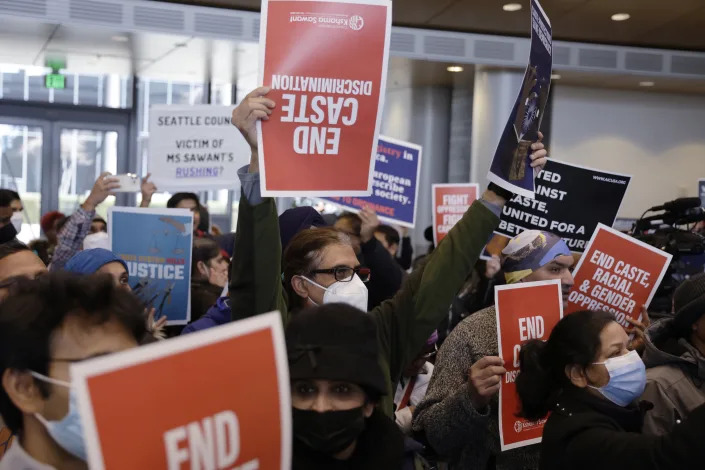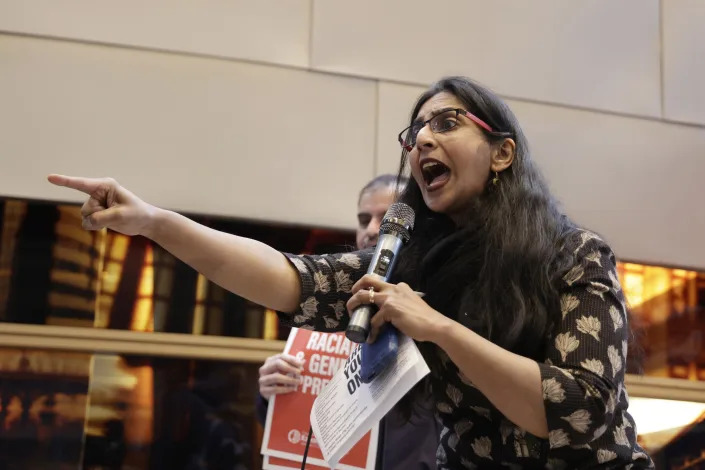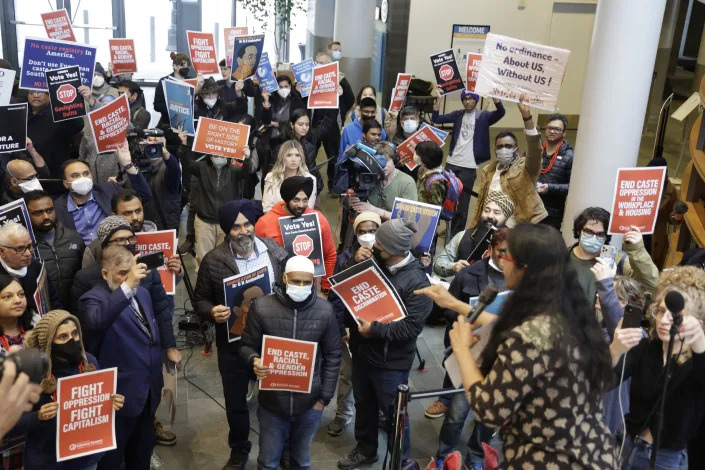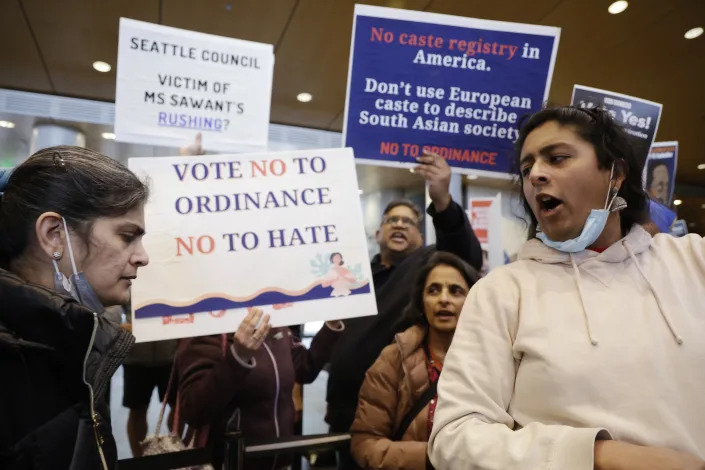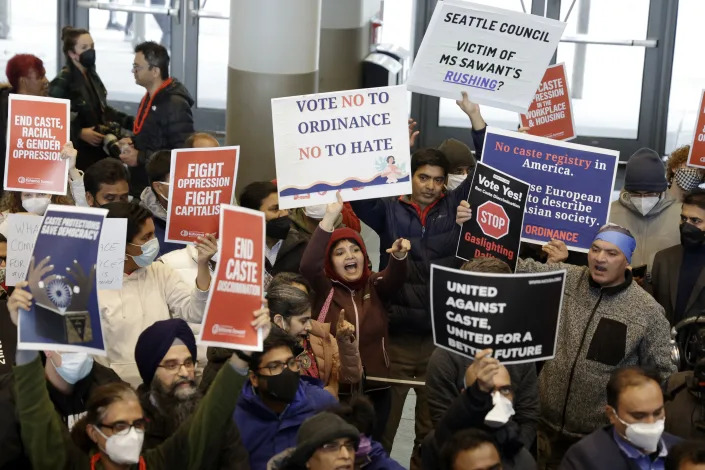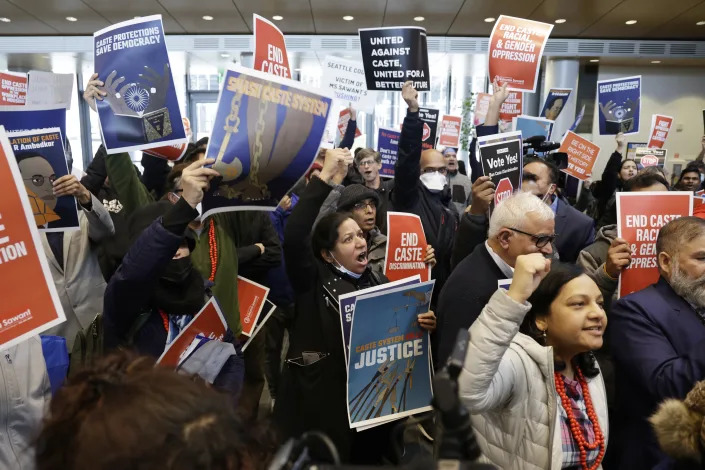10 PALESTINIANS KILLED
What's behind the Israeli army's deadly Nablus arrest raid?

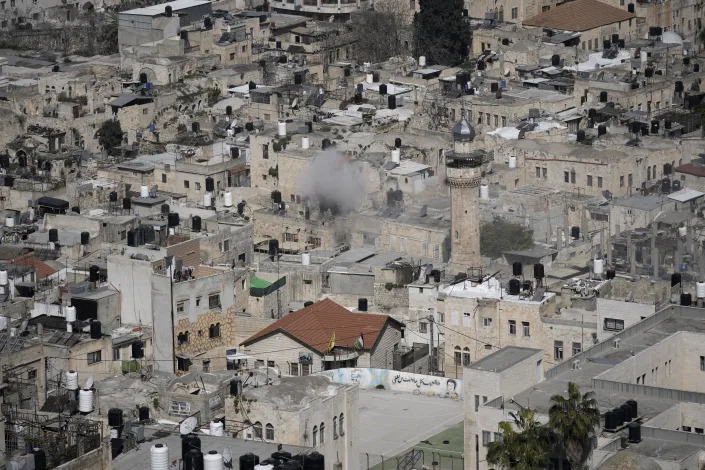


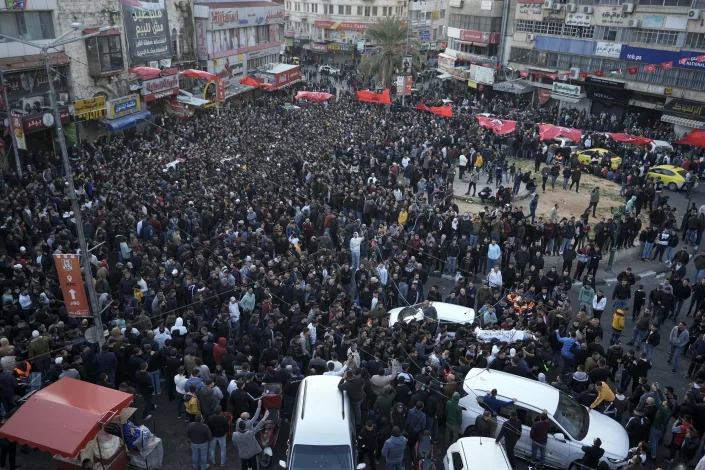
Palestinians carry the bodies of 10 men killed in clashes with Israel troops in the West Bank city of Nablus, Wednesday, Feb. 22, 2023. Palestinian officials say that at least 10 Palestinians have been killed and 102 were wounded during a rare daytime Israeli army arrest raid in the occupied West Bank. The Palestinian Health Ministry says a 72-year-old man was among the dead.
What's behind the Israeli army's deadly Nablus arrest raid?





Palestinians carry the bodies of 10 men killed in clashes with Israel troops in the West Bank city of Nablus, Wednesday, Feb. 22, 2023. Palestinian officials say that at least 10 Palestinians have been killed and 102 were wounded during a rare daytime Israeli army arrest raid in the occupied West Bank. The Palestinian Health Ministry says a 72-year-old man was among the dead.
(AP Photo/Majdi Mohammed)
ISABEL DEBRE
Wed, February 22, 2023
JERUSALEM (AP) — The northern West Bank city of Nablus, the Palestinian commercial center, resembled a war zone on Wednesday, after a daytime Israeli military raid triggered a firefight that killed at least 10 Palestinians and wounded more than 100 others.
It was the latest bloody escalation in a monthslong surge of Israeli raids into the the occupied territory that has led to the deaths of some 200 Palestinians and the arrest of at least 2,600 others. Last month, a similarly deadly raid in the northern West Bank city of Jenin triggered a Palestinian attack outside a synagogue in Jerusalem and a burst of rocket fire from Gaza.
This period of heightened violence in the West Bank and east Jerusalem has prompted comparisons with aspects of the second intifada, or Palestinian uprising, in the early 2000s and stoked fears of further bloodshed under the most right-wing government in Israel’s history. Prime Minister Benjamin Netanyahu’s new ultranationalist coalition has vowed to take a hard-line stance against the Palestinians and to entrench Israeli rule over lands they seek for a future state.
WHY DID THE ISRAELI ARMY ENTER NABLUS?
Much of the violence between Israelis and Palestinians for the past year has focused on Nablus, along with the nearby city of Jenin. The Israeli military said Wednesday's daytime raid targeted a Nablus-based armed group of young men known as the Lions’ Den, which emerged last year. The group has surged in popularity among Palestinians who see them as heroes for fighting Israel’s open-ended occupation of the West Bank, now in its 56th year. Although the Lion’s Den portrays itself as independent of established Palestinian factions, experts say the group is funded by Islamist militant groups Hamas and Palestinian Islamic Jihad. Israel has blamed the Lion’s Den for a string of shootings aimed at troops and Israeli settlements in the past months, including one that killed a soldier last October.
WHY DID THE RAID TAKE PLACE DURING THE DAY?
The Israeli army usually raids cities in the West Bank late at night in what it says is a tactic meant to reduce the risk of civilian casualties. But on Wednesday, as Israeli military vehicles rumbled into Nablus' Old City, its warren of homes and shops teeming with vendors and residents going about their routines under the bright sky. Fighting between Israeli security forces and Palestinian gunmen erupted in the stone alleys and the Israeli army even fired missiles at a house after the militants holed up there refused to surrender. The Israeli military said intelligence services had tracked down three wanted members of the Lion’s Den, including one involved in the killing of the Israeli soldier last fall, and determined they were all in the same house — offering a rare window of opportunity to target them. The army claimed the militants posed an immediate threat to Israeli lives, without providing evidence.
WHO WAS KILLED IN THE RAID?
At least 10 Palestinians were killed, including a 16-year-old boy and older men 72 and 61. The Lion’s Den claimed six of the dead as its members. A 66-year-old later died from tear gas inhalation, officials said. Other men were killed in unclear circumstances that the Israeli army said it was investigating. CCTV footage widely shared online showed two young men, apparently unarmed, shot after sprinting down the street, away from echoing gunfire. Another video circulating on social media, confirmed by witnesses, shows the body of 72-year-old Adnan Baara inert on the ground of the Old City market, his clothes covered in dust, beside a cart of bread. “We’re looking into everything,” said Lt. Col. Richard Hecht, an army spokesman. So far this year, at least 59 Palestinians have been killed in the West Bank and east Jerusalem, according to a tally by The Associated Press. While many of those killed in recent army raids are militants, stone-throwing youths protesting the incursions and others not involved in confrontations have also been killed.
WHY WAS THE DEATH TOLL SO HIGH?
The Israeli military said that its troops came under heavy fire as they stormed into the city. Young Palestinian men are increasingly taking up guns and organizing into small militant groups. The Israeli army’s escalating efforts to pursue them last year led to bloodshed in the West Bank at levels not seen since 2004. Fed up with the Israeli occupation that constrains their lives and disillusioned by the long-stalemated peace process and the unpopular Palestinian Authority that exercises limited control in parts of the West Bank, many young Palestinians have gotten their hands on M-16s, often smuggled from Israeli army bases or neighboring Jordan. Instead of slinging stones at troops entering their towns, they open fire. Israeli forces fire back. During a raid into the Jenin refugee camp last month, 10 Palestinians were killed, including a 61-year-old woman peering out at the chaos from her apartment window.
WHAT HAPPENS NEXT?
The Islamist militant group that rules the Gaza Strip, Hamas, issued a veiled threat after the deadly raid, saying its “patience is running out.” Senior Palestinian official Hussein al-Sheikh said that the Palestinian Authority is “considering taking steps at all levels in response,” without elaborating. Its options are limited. After last month’s raid in Jenin, the PA suspended security coordination with Israel, a move it has announced before with little impact. Although Israel says that its stepped-up arrest raids in the West Bank are intended to prevent future attacks, Palestinian residents and critics say the operations only inflame a ceaseless cycle of hatred and bloodshed. The Lion's Den on Wednesday promised revenge. “The size of the pain that befell Nablus today," it warned, “Israel will swallow twice as much.”
ISABEL DEBRE
Wed, February 22, 2023
JERUSALEM (AP) — The northern West Bank city of Nablus, the Palestinian commercial center, resembled a war zone on Wednesday, after a daytime Israeli military raid triggered a firefight that killed at least 10 Palestinians and wounded more than 100 others.
It was the latest bloody escalation in a monthslong surge of Israeli raids into the the occupied territory that has led to the deaths of some 200 Palestinians and the arrest of at least 2,600 others. Last month, a similarly deadly raid in the northern West Bank city of Jenin triggered a Palestinian attack outside a synagogue in Jerusalem and a burst of rocket fire from Gaza.
This period of heightened violence in the West Bank and east Jerusalem has prompted comparisons with aspects of the second intifada, or Palestinian uprising, in the early 2000s and stoked fears of further bloodshed under the most right-wing government in Israel’s history. Prime Minister Benjamin Netanyahu’s new ultranationalist coalition has vowed to take a hard-line stance against the Palestinians and to entrench Israeli rule over lands they seek for a future state.
WHY DID THE ISRAELI ARMY ENTER NABLUS?
Much of the violence between Israelis and Palestinians for the past year has focused on Nablus, along with the nearby city of Jenin. The Israeli military said Wednesday's daytime raid targeted a Nablus-based armed group of young men known as the Lions’ Den, which emerged last year. The group has surged in popularity among Palestinians who see them as heroes for fighting Israel’s open-ended occupation of the West Bank, now in its 56th year. Although the Lion’s Den portrays itself as independent of established Palestinian factions, experts say the group is funded by Islamist militant groups Hamas and Palestinian Islamic Jihad. Israel has blamed the Lion’s Den for a string of shootings aimed at troops and Israeli settlements in the past months, including one that killed a soldier last October.
WHY DID THE RAID TAKE PLACE DURING THE DAY?
The Israeli army usually raids cities in the West Bank late at night in what it says is a tactic meant to reduce the risk of civilian casualties. But on Wednesday, as Israeli military vehicles rumbled into Nablus' Old City, its warren of homes and shops teeming with vendors and residents going about their routines under the bright sky. Fighting between Israeli security forces and Palestinian gunmen erupted in the stone alleys and the Israeli army even fired missiles at a house after the militants holed up there refused to surrender. The Israeli military said intelligence services had tracked down three wanted members of the Lion’s Den, including one involved in the killing of the Israeli soldier last fall, and determined they were all in the same house — offering a rare window of opportunity to target them. The army claimed the militants posed an immediate threat to Israeli lives, without providing evidence.
WHO WAS KILLED IN THE RAID?
At least 10 Palestinians were killed, including a 16-year-old boy and older men 72 and 61. The Lion’s Den claimed six of the dead as its members. A 66-year-old later died from tear gas inhalation, officials said. Other men were killed in unclear circumstances that the Israeli army said it was investigating. CCTV footage widely shared online showed two young men, apparently unarmed, shot after sprinting down the street, away from echoing gunfire. Another video circulating on social media, confirmed by witnesses, shows the body of 72-year-old Adnan Baara inert on the ground of the Old City market, his clothes covered in dust, beside a cart of bread. “We’re looking into everything,” said Lt. Col. Richard Hecht, an army spokesman. So far this year, at least 59 Palestinians have been killed in the West Bank and east Jerusalem, according to a tally by The Associated Press. While many of those killed in recent army raids are militants, stone-throwing youths protesting the incursions and others not involved in confrontations have also been killed.
WHY WAS THE DEATH TOLL SO HIGH?
The Israeli military said that its troops came under heavy fire as they stormed into the city. Young Palestinian men are increasingly taking up guns and organizing into small militant groups. The Israeli army’s escalating efforts to pursue them last year led to bloodshed in the West Bank at levels not seen since 2004. Fed up with the Israeli occupation that constrains their lives and disillusioned by the long-stalemated peace process and the unpopular Palestinian Authority that exercises limited control in parts of the West Bank, many young Palestinians have gotten their hands on M-16s, often smuggled from Israeli army bases or neighboring Jordan. Instead of slinging stones at troops entering their towns, they open fire. Israeli forces fire back. During a raid into the Jenin refugee camp last month, 10 Palestinians were killed, including a 61-year-old woman peering out at the chaos from her apartment window.
WHAT HAPPENS NEXT?
The Islamist militant group that rules the Gaza Strip, Hamas, issued a veiled threat after the deadly raid, saying its “patience is running out.” Senior Palestinian official Hussein al-Sheikh said that the Palestinian Authority is “considering taking steps at all levels in response,” without elaborating. Its options are limited. After last month’s raid in Jenin, the PA suspended security coordination with Israel, a move it has announced before with little impact. Although Israel says that its stepped-up arrest raids in the West Bank are intended to prevent future attacks, Palestinian residents and critics say the operations only inflame a ceaseless cycle of hatred and bloodshed. The Lion's Den on Wednesday promised revenge. “The size of the pain that befell Nablus today," it warned, “Israel will swallow twice as much.”
 |
| USING THE WEAPON OF DAVID AGAINST THE ZIONIST GOLIATH Israeli troops kill 10 Palestinians, hurt 100 in West Bank clash -medics  Wed, February 22, 2023 By Ali Sawafta NABLUS, West Bank (Reuters) - Israeli troops killed 10 Palestinians, including at least three gunmen and three civilians, and wounded over 100 others during a raid on a flashpoint city in the occupied West Bank on Wednesday, witnesses and medical officials said. The Israeli military confirmed the operation in Nablus, saying troops shot back after coming under fire while trying to detain militants suspected of planning imminent attacks. There were no Israeli casualties, an army statement said. Palestinian militant faction Islamic Jihad said two of its Nablus commanders had been encircled in a house by Israeli troops, triggering a clash that drew in other gunmen. Explosions sounded and local youths pelted armoured troop transports with rocks. Palestinian sources said the two Islamic Jihad commanders were killed along with another gunman. The fatalities also included at least three civilians, among them a 72-year-old man and a 14-year-old boy. Medical officials said 102 Palestinians were wounded, six of them critically. In a briefing with reporters, a senior Israeli military official said the raid lasted around four hours, with troops coming under heavy fire from rooftops and armoured gunmen on motorcycles. Nablus and nearby Jenin have been a focus of raids that Israel has intensified over the last year following a spate of lethal Palestinian street attacks in its cities. Sixty-one Palestinians, including gunmen and civilians, have been killed in 2023, the Palestinian health ministry said. Ten Israelis and a Ukrainian tourist died in Palestinian attacks in the same period, according to Israel's foreign ministry. "We condemn the occupation's raid into Nablus and we call for an end to the continued attacks against our people," said Nabil Abu Rudeineh, spokesperson for Palestinian President Mahmoud Abbas. Hamas, another Palestinian militant group that sometimes fights alongside Islamic Jihad, said there were four gunmen, one from its own ranks, and hinted at possible reprisals from the Gaza Strip, a territory that it controls. "The resistance in Gaza is monitoring the escalating crimes conducted by the enemy against our people in the occupied West Bank and is running out of patience," Abu Ubaida, spokesman for the Hamas armed wing, said on Telegram. In a statement Saudi Arabia condemned the raid. The foreign ministry of Egypt, which often acts as a broker between Israel and Hamas, in a statement "expressed extreme concern" over the escalation and its potential to "undermine the efforts to achieve calm between the Palestinian and Israeli sides." Hamas and Islamic Jihad are sworn to Israel's destruction but have in the past observed Egyptian-mediated truces with it. U.S.-sponsored Palestinian statehood talks have been stalled for almost a decade. (Additional reporting by Nidal al-Mughrabi; Writing by Dan Williams; editing by Mark Heinrich and Bernadete Baum) 10 Palestinians killed, scores hurt in Israel West Bank raid PHOTO ESSAY 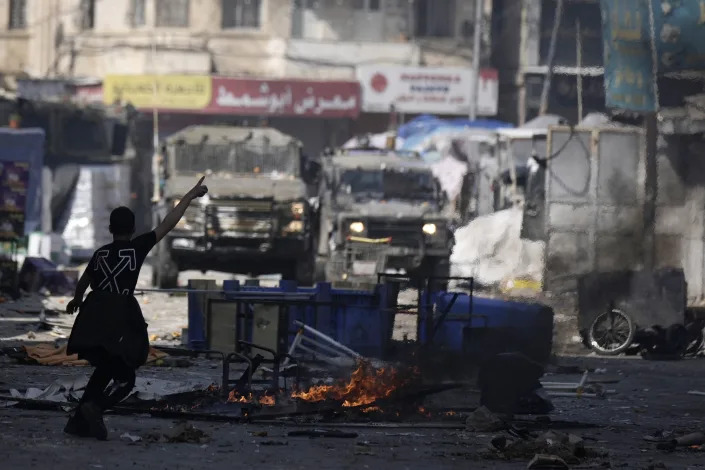  2 / 15 A Palestinian gestures to Israeli military vehicles during clashes in the West Bank city of Nablus, Wednesday, Feb. 22, 2023. Israeli troops moved into the city, setting off fighting that killed several Palestinians, including a 72-year-old man, Palestinian health officials said. The Israeli military gave few details about its operation in the northern city, which is known as a militant stronghold, and the army frequently operates there. (AP Photo/Majdi Mohammed) AREF TUFAHA and JOSEF FEDERMAN Wed, February 22, 2023 NABLUS, West Bank (AP) — Israeli troops on Wednesday entered a major Palestinian city in the occupied West Bank in a rare, daytime arrest operation, triggering fighting that killed at least 10 Palestinians and wounded scores of others. The raid, which reduced a building to rubble and left a series of shops riddled with bullets, was one of the bloodiest battles in nearly a year of fighting in the West Bank and east Jerusalem. Two men, ages 72 and 61, were among the dead, and 102 people were wounded, Palestinian officials said. The Israeli operation, coupled with the high death toll, raised the prospect of further bloodshed. A similar raid last month was followed by a deadly Palestinian attack outside a Jerusalem synagogue, and the Hamas militant group warned that “its patience is running out.” In a move that could further raise tensions, Israel's West Bank settler organization said that Israeli officials had approved construction of nearly 2,000 new homes in West Bank settlements. The Israeli government did not immediately confirm the decision, which came just two days after the U.N. Security Council approved a watered-down statement opposing settlement construction. U.N. Secretary-General Antonio Guterres warned Wednesday that the situation in the occupied Palestinian territory “is at its most combustible in years,” calling Israel’s operation in Nablus that left 10 Palestinians dead and over 80 injured “deeply concerning.” He urged stepped-up efforts to prevent the further escalation of violence, reduce tensions and restore calm. The Israeli military said it entered Nablus on Wednesday to arrest three wanted militants suspected in previous shooting attacks in the West Bank, including the killing of an Israeli soldier last fall. The military usually conducts raids at night in what it says is a tactic meant to reduce the risk of civilian casualties. It said it took advantage of a rare window of opportunity after intelligence services tracked down the men in a hideout and warned they posed an imminent threat. The army said it surrounded the building and asked the men to surrender, but instead they opened fire. When one of the militants tried to flee the building, he was shot and killed, said Lt. Col. Richard Hecht, a military spokesman. The military then fired missiles at the house, he added, leaving it in ruins and killing the other two men. A recently formed armed group based in the Old City of Nablus called the Lion's Den, which has surged in prominence over the past months, confirmed the militants were its members. During the raid, the military said armed men in the city “shot heavily toward the forces,” which responded with live fire. It said others hurled rocks and explosives at the troops. The military released a video taken from inside an armored vehicle as crowds of Palestinian youths pelt it with stones. There were no Israeli casualties. Time-stamped security footage widely shared online appeared to show two unarmed young men running down a street. Gunshots are heard, and both fall to the ground, with one’s hat flying off his head. Both bodies remained still. Hecht called the video “problematic," and said the military was looking into it. In the Old City of Nablus, people stared at the rubble that had been the large home in the centuries-old marketplace. From one end to the other, shops were riddled with bullets. Parked cars were crushed. Blood stained the cement ruins. Furniture from the destroyed home was scattered among mounds of debris. The Palestinian Health Ministry said 102 people were wounded, and six of them were in critical condition. Various Palestinian militant groups claimed six of the dead — including the three from Lion's Den targeted in the raid — as members. But two men, ages 72 and 61, were also killed. There was no immediate word on whether the others belonged to armed groups. Last month, Israeli troops killed 10 people in a similar raid in the northern West Bank. The following day, a lone Palestinian gunman opened fire near a synagogue in an east Jerusalem settlement, killing seven people. Days later, five Palestinian militants were killed in an Israeli arrest raid elsewhere in the West Bank. That was followed by a Palestinian car ramming that killed three Israelis, including two young brothers, in Jerusalem. The fighting comes at a sensitive time, less than two months after Israeli Prime Minister Benjamin Netanyahu's new hard-line government took office. The government is dominated by ultranationalists who have pushed for tougher action against Palestinian militants. Israeli media have quoted top security officials as expressing concern that this could lead to even more violence. Israeli police announced they were beefing up forces and going on heightened alert in the West Bank and east Jerusalem. The Cabinet includes a number of West Bank settler leaders, one of whom has been promised authority over settlement construction. Yesha, the settlement council, announced that Israeli planning officials had granted approval to nearly 2,000 new homes in settlements across the West Bank. The defense body that grants the approvals, the Civil Administration, said the meeting was still underway Wednesday and that an announcement would only be issued on Thursday, after the two-day session is over. The Palestinians and most of the international community say settlements built on occupied lands are illegal and obstacles to peace. Over 700,000 settlers now live in the West Bank and east Jerusalem, territories captured by Israel in 1967 and sought by the Palestinians for a future state. The Israeli decision comes in the wake of the U.N. presidential statement that strongly criticized settlements. The U.S. blocked what would have been a legally binding council resolution. American diplomats claimed to have extracted an Israeli pledge to halt unilateral action in order to block the resolution. The approval of new settlements by Israel would appear to defy that claim. In the Gaza Strip, a spokesman for the ruling Hamas militant group issued a veiled threat following the Nablus raid. “The resistance in Gaza is observing the enemy’s escalating crimes against our people in the occupied West Bank, and its patience is running out,” said Abu Obeida, a spokesman for the group. Late Wednesday, Palestinian activists burned tires along Gaza's frontier with Israel in protest. Hamas has battled Israel in four wars since seizing control of Gaza in 2007, and Israeli officials have expressed concerns about rising tensions ahead of the Muslim holy month of Ramadan, which begins in the second half of March. At least 55 Palestinians have been killed in the West Bank and east Jerusalem this year, a pace that could exceed last year's death toll. Last year, nearly 150 Palestinians were killed in the West Bank and east Jerusalem, making it the deadliest year in those areas since 2004, according to figures by the Israeli rights group B’Tselem. Israel says that most of those killed have been militants but others — including youths protesting the incursions and other people not involved in confrontations — have also been killed. An AP tally has found that just under half of those killed belonged to militant groups. Israel says the military raids are meant to dismantle militant networks and thwart future attacks while the Palestinians view them as further entrenchment of Israel’s open-ended, 55-year occupation. Israel captured the West Bank, east Jerusalem and the Gaza Strip in the 1967 Mideast war, territories the Palestinians seek for their hoped-for independent state. ___ Federman reported from Jerusalem. |





